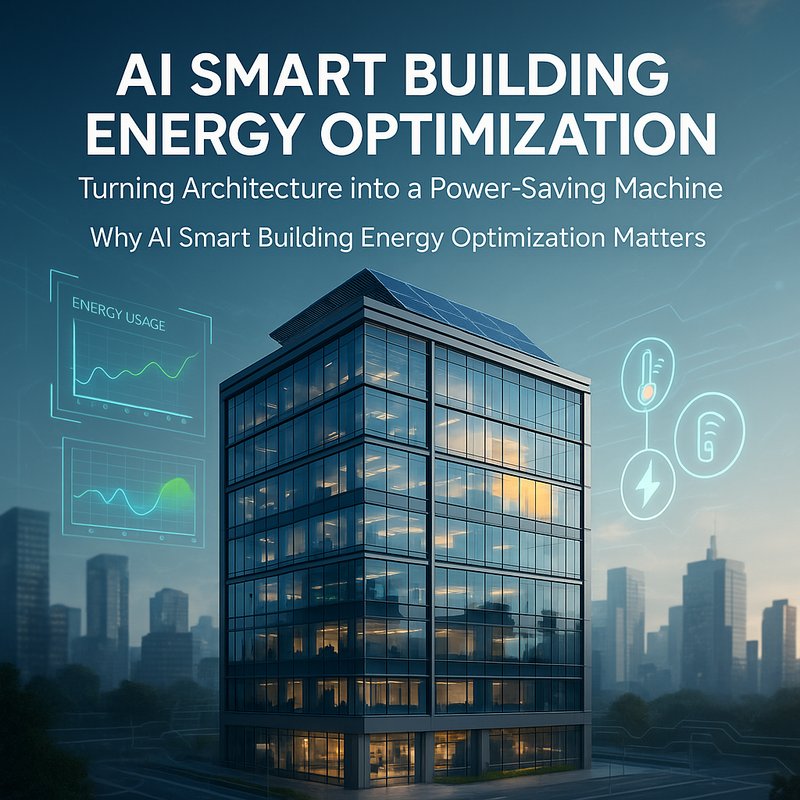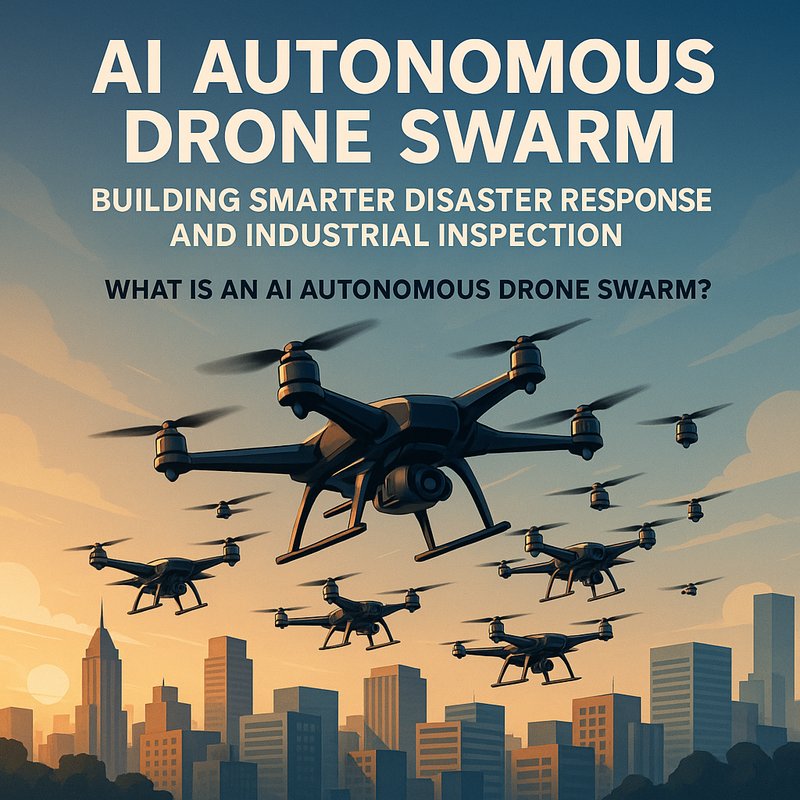AI smart building energy optimization is a technology that turns every sensor and device inside a building into a tiny brain that learns how to use electricity, water, and heating more efficiently. It blends real‑time data, predictive models, and automated controls so that a building can lower its bills while staying comfortable for occupants. In the next two thousand words we’ll explore how it works, why it matters, the building blocks you need, and a clear roadmap for putting it into practice.
Why AI Smart Building Energy Optimization Matters
Building energy consumption is a huge slice of global carbon emissions, and it costs businesses and homeowners a lot of money.
When a building uses AI smart building energy optimization, it can:
- Cut energy bills by 10 %–30 % in many cases
- Reduce peak demand, easing strain on the local grid
- Extend the life of HVAC and lighting systems by avoiding over‑use
- Provide data that helps managers make smarter long‑term renovation decisions
These gains add up quickly. For a 100‑kW commercial building, a 15 % reduction means about €1,500 saved each month, or €18,000 per year.
Core Building Blocks of an AI Smart Building Energy Optimization System
| Layer | What It Does | How AI Helps |
|---|---|---|
| Sensors & IoT | Collect temperature, humidity, occupancy, power use, and equipment status | Provides raw data for analysis |
| Data Integration Platform | Ingests data into a unified format and time‑series database | Normalizes signals, handles missing values |
| AI Models | Forecast demand, detect anomalies, optimize schedules | Learns patterns, predicts tomorrow’s usage |
| Control Engine | Sends commands to HVAC, lighting, and other actuators | Automates adjustments in real time |
| Visualization Dashboard | Shows real‑time metrics and alerts | Helps operators monitor performance |
| Feedback Loop | Human operators validate AI decisions and retrain models | Keeps the system accurate and relevant |
Sensors & IoT Devices
A modern building already has many devices: smart thermostats, occupancy sensors, smart meters, and sometimes even IoT‑enabled light fixtures. For AI smart building energy optimization you need sensors that measure:
- Electrical – smart meters for each major system (HVAC, lighting, IT)
- Environmental – temperature, CO₂, humidity, light levels
- Occupancy – infrared, video‑based counting, Wi‑Fi connection counts
- Equipment – motor status, compressor cycles, valve positions
These sensors feed data every few seconds to a cloud or edge platform.
Data Integration Platform
Choosing the right platform is crucial. Popular choices include:
- Azure IoT Hub – integrates well with Microsoft Azure services
- AWS IoT Core – offers robust scalability and analytics
- ** Cloud IoT Core** – great for hybrid deployments
- Open‑source – Apache Kafka combined with TimescaleDB
The platform pulls raw sensor readings, normalises units, timestamps them, and writes them to a time‑series database that can handle millions of points per day.
AI Models for Energy Forecasting
The heart of AI smart building energy optimization is the model that tells you what the building will need and when it will need it. Common model types include:
- Long Short‑Term Memory (LSTM) networks that predict hourly or minute‑by‑minute energy usage based on past patterns.
- Prophet or ARIMA models for medium‑term demand forecasting.
- Convolutional Neural Networks (CNN) that spot anomalies in power curves, such as a sudden spike from a malfunctioning appliance.
- Reinforcement Learning agents that learn to adjust setpoints to minimise cost while maintaining comfort.
These models are trained on historical data and continually updated as new data streams in.
Edge vs. Cloud Computing
Processing all data in the cloud can create latency and bandwidth costs. For AI smart building energy optimization, a hybrid approach works best:
- Edge – lightweight models run on local gateways or building management systems to adjust HVAC setpoints instantly.
- Cloud – heavier models (deep learning, multi‑building forecasting) run in the cloud, feeding back updated parameters to the edge.
This split keeps response times short while leveraging the power of the cloud for deeper analytics.
Control Engine and Automation
Once the AI predicts demand and detects anomalies, the control engine pushes commands to the building’s actuators:
- HVAC – change temperature setpoints adjust fan speeds, schedule maintenance.
- Lighting – dim or brighten based on occupancy and daylight.
- Window Shades – open or close to manage heat gain/loss.
Automation scripts are built on standard protocols (BACnet, Modbus, KNX) so the system can work with most commercial equipment.

Visualization and Dashboard
A clear dashboard shows:
- Current energy usage vs. forecast
- Peak demand alerts
- Anomaly warnings (e.g., compressor cycling too often)
- Savings metrics (cumulative dollars saved, CO₂ offset)
Users can drill down to individual rooms or zones and view historical trends.
Feedback Loop
Even the smartest AI needs human oversight. When an alert appears, a building operator reviews it, verifies if it’s a real issue, and logs a response. That feedback is fed back into the model training pipeline, improving over time.
Step‑by‑Step Guide to Build a Pilot AI Smart Building Energy Optimization Project
- Define the Objective – Reduce HVAC energy by 15 % in six months.
- Audit Existing Infrastructure – List all smart meters, sensors, and control systems.
- Select a Data Platform – For example, Azure IoT Hub with Azure Time Series Insights.
- Deploy Edge Gateways – Install Raspberry Pi or industrial controllers to run local inference.
- Model Development – Build an LSTM in Python, train on the past year’s hourly consumption data.
- Integrate with Control Engine – Use BACnet APIs to adjust setpoints automatically.
- Create Dashboards – Build Power BI or Grafana dashboards that visualize savings.
- Run a 30‑Day Pilot – Monitor performance, collect operator feedback, and refine models.
- Scale – Extend the solution to additional zones, or roll out to other buildings.
During the pilot, track key metrics: average daily consumption, peak demand reduction, operator satisfaction, and model accuracy.
Real‑World Success Stories
| Building | Challenge | Solution | Outcome |
|---|---|---|---|
| Downtown Office Tower | High HVAC costs due to legacy control logic | Deployed AI smart building energy optimization with edge inference on HVAC setpoints | 18 % reduction in monthly energy bills; peak demand cut by 12 kW |
| Hotel Chain Headquarters | Variable occupancy leading to wasted energy | Implemented occupancy‑based lighting and HVAC scheduling using real‑time sensors | 22 % energy savings; improved guest comfort ratings |
| Data Center Facility | Cooling system inefficiencies | Applied predictive maintenance models to fan motors, integrated with load‑balancing | 15 % lower cooling cost; prevented unscheduled downtime |
These cases illustrate how AI smart building energy optimization can deliver tangible financial and environmental benefits across diverse building types.
Common Pitfalls and How to Avoid Them
| Pitfall | Fix |
|---|---|
| Missing or inaccurate sensor data | Perform a data quality audit; replace or recalibrate faulty sensors. |
| Model over‑fitting to historic patterns | Use cross‑validation; incorporate seasonal and weather variables. |
| Slow control response | Shift critical control logic to the edge; reduce round‑trip latency. |
| Operator pushback | Involve stakeholders early; provide clear training and quick wins. |
| Privacy concerns with occupant data | Anonymise location data; use aggregated occupancy metrics. |
Emerging Trends in AI Smart Building Energy Optimization
- Federated Learning – Building‑specific models train locally and share only parameter updates, protecting privacy.
- Digital Twin Integration – Combining an AI smart building energy optimization system with a building digital twin for more accurate scenario testing.
- Demand‑Response Coordination – AI models that coordinate with the grid to shift loads during peak pricing.
- Smart Asset Lifecycle Management – Predictive maintenance that extends HVAC and lighting component life by 20 %.
These trends promise even more efficient, resilient, and transparent building operations.
Why Businesses Should Invest
- Cost Savings – Immediate ROI from reduced energy bills.
- Regulatory Compliance – Many regions now require energy efficiency reporting.
- Competitive Advantage – Energy‑efficient buildings attract tenants and investors.
- Sustainability Goals – Reducing carbon footprint aligns with ESG mandates.
Getting Started with Neura AI
Neura AI’s platform offers ready‑made AI agents that can ingest building data, build forecasting models, and generate automated control actions. Check out the Neura ACE product at https://meetneura.ai/products for a full suite of tools that streamline the entire process from data ingestion to deployment.
You can also read real case studies at https://blog.meetneura.ai/#case-studies to see how others have benefited.
Conclusion
AI smart building energy optimization is no longer a futuristic idea. It’s a proven, data‑driven approach that lets buildings use energy more wisely, save money, and protect the planet. By combining sensors, cloud and edge computing, predictive models, and automated controls, you can turn any building into a smart, self‑optimising entity. Start small with a pilot, iterate quickly, and watch the savings roll in.

